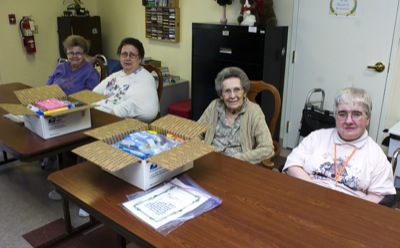Friday, March 4th, 2011
Pathologist says woman died hours before call placed
Wangler trial
By Margie Wuebker
LIMA - Mercer County native Kathy Wangler died one to two hours before her husband's 911 call from their Lima home resulted in an emergency run to Lima Memorial Hospital, according to testimony offered during the second day of Dr. Mark Wangler's aggravated murder trial.
Dr. Diane Scala Barnett, a forensic pathologist with the Lucas County Coroner's Office in Toledo, took the stand for the prosecution Thursday. Barnett performed an autopsy on Kathy Wangler on Sept. 5, 2006, a day after the mother of two died from what was determined to be acute carbon monoxide intoxication. Testimony from other prosecution witnesses appearing in Allen County Common Pleas Court focused on a portable generator and other equipment as a possible source of the toxic gas.
Barnett, who has performed more than 8,000 autopsies and testified in numerous court cases, said she based her opinion on numerous factors, including body temperature, pooling of the blood in the capillaries, rigor mortis and evaluation of stomach contents. She also took into consideration the reports of squad and emergency room personnel who initially tended to Kathy Wangler.
Also Thursday, Dr. Rina Stein testified on her observations when Kathy Wangler arrived in the hospital emergency room Sept. 4 and Mark Wangler's demeanor upon being notified of his wife's death.
"It seemed to me from my experience of 22 years she had been dead a lot longer," Stein said in reference to the 911 call at 5:17 a.m. and the patient's arrival at 5:48 a.m.
Mark Wangler, an anesthesiologist who grew up in Fort Recovery, told rescue personnel, emergency room employees and law enforcement officers that he was awakened by the shrill sound of a carbon monoxide detector emanating from the basement of his Bath Township home and went to check on his wife in an upstairs bedroom. He said he found her in the midst of a seizure and initiated CPR when she stopped breathing.
Stein testified Mark Wangler appeared emotional when she notified him of his wife's death. She said he appeared to be crying, but she didn't notice any telltale signs of tears or nasal discharge.
Mark Wangler later received oxygen treatment at the hospital after tests determined his carbon monoxide level at 13 percent compared to his wife's nearly 70 percent level at autopsy.
Lead defense attorney Christopher McDowell cited discrepancies in hospital records: Kathy Wangler's body temperature was listed as 94 degrees in one place and 95.5 in another, and the squad report noted the patient had been intubated but the emergency physician indicated the procedure had not occurred because of her fixed mouth and stiff neck.
Under questioning by the defense, Barnett said body temperature varies from person to person in a range of 97 to 99.5 degrees. Medical records from a routine doctor's visit indicated Kathy Wangler's baseline reading at 97.5 degrees.
She also responded to McDowell's questioning that muscles become flaccid following death. Pointing to medical books lying on the defense table, the attorney asked whether she had heard of a certain type of spasm that causes sudden muscle contracture and she answered affirmatively. The cross examination also involved Wangler's statements about his wife's having a seizure.
"You don't seize when you're dead," Barnett said in reference to her opinion on the estimated time of death.
The forensic pathologist reported finding no soot in the dead woman's airway during autopsy, although photographs showed soot traces above a register in the room where she was found. Barnett indicated soot is common in fire victims who breathe in smoke and finding none was more consistent with an internal combustion source.
The presence of pink foamy fluid in the lungs indicated Kathy Wangler was "fighting to breathe" prior to death, according to Barnett.
Dr. Robert B. Forney, chief forensic toxicologist at the coroner's office, pegged the concentration of carbon monoxide level in the dead woman's blood at 69.6 percent. Tests pinpointed the presence of two anti-seizure medications. However, he admitted under questioning from the prosecution that some readily available drugs frequently do not show up in test results, which look for approximately 100 of an estimated 250,000 commonly used chemicals or drugs.
Mark Wangler looked away when Allen County Prosecutor Juergen Waldick showed a photograph of his wife's body taken in the emergency room. It was the only emotion he exhibited during the daylong proceeding other than shaking his head as if refuting some of the medical testimony.
Law enforcement officers called to the witness stand described what they saw in the home and attached two-car garage. Sgt. Phillip Sherrick said he walked through the unkempt home littered with clothing and shopping bags the morning of Kathy's death. He said he returned the following day after Wangler called to report finding considerable jewelry, multiple credit cards and $1,500 in cash in his wife's Lincoln Continental.
At some point during his second visit, Mark Wangler went into the garage, according to Sherrick's testimony. The officer said he followed and found Wangler "messing with" gas cans near a portable generator, a snowblower and a lawnmower. Upon questioning, the doctor indicated he was merely checking the cans to make sure there was enough gas to mow the lawn, Sherrick testified.
McDowell questioned Sherrick about possible movement of the generator. Sherrick said he had no idea if the generator, snowblower or lawnmower were operable.
Sherrick identified photographs showing soot residue above a register in the upstairs bedroom where Kathy was found. Firefighters found the highest level of carbon monoxide concentration in that room.
He also reported finding the window open and a fan operating in the master bedroom. He noticed a wet area on the master bathroom floor and a sulphur-like smell, attributing the discoveries to Mark Wangler's statements about his wife's causing the toilet to overflow.
Investigator Mark Murphy was grilled by attorneys from the prosecution and defense regarding hoses found in the storage compartment of an older model motorhome parked in the Wangler driveway. There was no attempt to link the hoses to any of the items in the garage.
Testimony resumed at 8:30 a.m. today.






